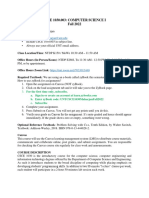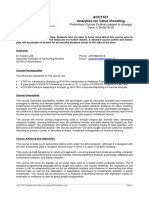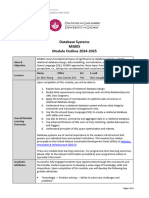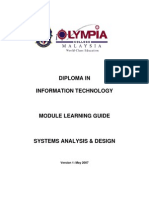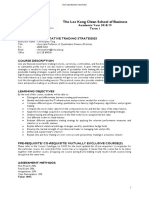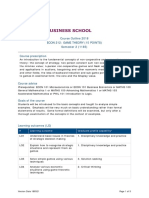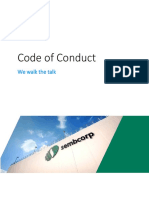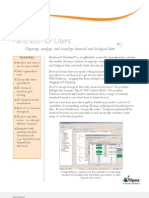ACCT418 Data Modelling & Visualization: Instructor
ACCT418 Data Modelling & Visualization: Instructor
Uploaded by
Hohoho134Copyright:
ACCT418 Data Modelling & Visualization: Instructor
ACCT418 Data Modelling & Visualization: Instructor
Uploaded by
Hohoho134Original Description:
Original Title
Copyright
Share this document
Did you find this document useful?
Is this content inappropriate?
Copyright:
ACCT418 Data Modelling & Visualization: Instructor
ACCT418 Data Modelling & Visualization: Instructor
Uploaded by
Hohoho134Copyright:
SMU Classification: Restricted
ACCT418
Data Modelling & Visualization
Instructor
Clarence GOH
Course Prerequisites
ACCT 101 Financial Accounting
Course Description
Accountants regularly work with large amounts of financial and non-financial data. Data modelling is an
important means through which accountants can analyse such data for trends, patterns, relationships, and
other useful information for decision making. This course will introduce a variety of quantitative techniques
used in the development, implementation, and utilization of analytical data models that accountants
regularly use in decision making. It will cover techniques including regression analysis, trend analysis,
optimization, text analytics, and simulation.
Visualization provides an important means through which accountants can communicate insights obtained
via data modelling to their intended recipients. Well-designed visualisations can improve the memory,
comprehension, and decision making of intended recipients of this information. This course will introduce
students to key principles and techniques for data visualization. Students will create visuals including
dashboards and interactive visualisations for decision making in the accounting context.
Texts and Other Resources
Readings:
Course notes and selected articles from various sources will be provided.
Other Resources:
MS Excel will be used extensively during the course. Students are to ensure that the following add-ins are
enabled in MS Excel:
1) Power Pivot - https://support.office.com/en-us/article/Start-the-Power-Pivot-in-Microsoft-Excel-
add-in-a891a66d-36e3-43fc-81e8-fc4798f39ea8
2) Power View - https://support.office.com/en-us/article/Turn-on-Power-View-in-Excel-2016-for-
Windows-f8fc21a6-08fc-407a-8a91-643fa848729a
3) Analysis ToolPak - https://support.office.com/en-us/article/Use-the-Analysis-ToolPak-to-perform-
complex-data-analysis-6c67ccf0-f4a9-487c-8dec-bdb5a2cefab6#__toc309744625
Mac users may also have to install Bootcamp (from the IT Help Centre) in order to run the add-ins.
Other tools that will be used include Rapid Miner and Tableau.
ACCT418 Data Modelling and Visualization Page 1
SMU Classification: Restricted
Assessment
To pass this course, a student is required to obtain a total mark of 50% or better. The assessment
components for this course are:
Class participation 10%
Take home assignments 25%
Group project I 10%
Group project II 20%
Final Exam 35%
Total 100%
Lesson Plan
Class sessions are of three-hour duration per week. The following is a tentative lesson plan:
Week Topic
1 Introduction to data modelling and visualization
2 Data visualization I
3 Data visualization II
4 Preparing a dashboard
5 Regression analysis
6 Time series analysis
7 Optimization
8 TERM BREAK
9 Simulation
10 Text analytics
11 Forensic analytics
12 Project presentation
13 Course summary
The detailed course work plan will be announced in class. Note that this schedule is subject to
change. Alternative times or activities will be arranged should they become necessary.
Academic Integrity
All acts of academic dishonesty (including, but not limited to, plagiarism, cheating, fabrication,
facilitation of acts of academic dishonesty by others, unauthorized possession of exam
questions, or tampering with the academic work of other students) are serious offences. All
work (whether oral or written) submitted for purposes of assessment must be the student’s
own work. Penalties for violation of the policy range from zero marks for the component
assessment to expulsion, depending on the nature of the offense. When in doubt, students
should consult the instructors of the course. Details on the SMU Code of Academic Integrity
may be accessed at http://www.smuscd.org/resources.html.
ACCT418 Data Modelling and Visualization Page 2
SMU Classification: Restricted
Accessibility
SMU strives to make learning experiences accessible for all. If you anticipate or experience
physical or academic barriers due to disability, please let me know immediately. You are also
welcome to contact the university's disability services team if you have questions or concerns
about academic provisions: included@smu.edu.sg. Please be aware that the accessible
tables in our seminar room should remain available for students who require them.
Emergency Preparedness for Teaching and Learning (EPTL)
As part of emergency preparedness, Instructors may conduct lessons online via the WebEx
platform during the term, to prepare students for online learning. During an actual emergency,
students will be notified to access the WebEx platform for their online lessons. The class
schedule will mirror the current face-to-face class timetable unless otherwise stated.
Prepared by: Clarence Goh, June 2018
Vetted by: Seow Poh Sun, 19 Jun 2018
ACCT418 Data Modelling and Visualization Page 3
You might also like
- Grade 9 Math Textbook PDF OntarioDocument2 pagesGrade 9 Math Textbook PDF OntarioJenny10% (10)
- MEM 506 OR & Simulation SyllabusDocument6 pagesMEM 506 OR & Simulation SyllabusElectronNo ratings yet
- Cits1401 2015 Sem-1 CrawleyDocument3 pagesCits1401 2015 Sem-1 CrawleyDoonkieNo ratings yet
- CSCE 1030.003 Sasdfyllabus-Fall 2022Document7 pagesCSCE 1030.003 Sasdfyllabus-Fall 2022John Caleb TimpaniNo ratings yet
- Syllabus For Buan-Opre 6398.001 - Sp22Document7 pagesSyllabus For Buan-Opre 6398.001 - Sp22SHRUTI KHANNANo ratings yet
- MAEG4050 Syllabus 2017-18Document4 pagesMAEG4050 Syllabus 2017-18horace LinNo ratings yet
- ACCT421 Analytics For Value Investing: Preliminary Course Outline (Subject To Change) Term 1, AY2018-19Document3 pagesACCT421 Analytics For Value Investing: Preliminary Course Outline (Subject To Change) Term 1, AY2018-19Hohoho134No ratings yet
- Acct221 - Wong Suay PengDocument3 pagesAcct221 - Wong Suay PengHohoho134No ratings yet
- 621 SyllabusDocument8 pages621 SyllabusSefakor AwuramaNo ratings yet
- Accounting Information System SyllabusDocument4 pagesAccounting Information System SyllabusKemas DestiaNo ratings yet
- Syllabus DATANDocument6 pagesSyllabus DATANmuhammad tody arsyiantoNo ratings yet
- Department of Management: Course: Title: Prerequisites: MGT 3110 Credit: Faculty: TextsDocument5 pagesDepartment of Management: Course: Title: Prerequisites: MGT 3110 Credit: Faculty: TextsAchmad AlfianNo ratings yet
- Syllabus For Ics3uDocument6 pagesSyllabus For Ics3uSamNo ratings yet
- Math3851 2022T3Document8 pagesMath3851 2022T3DouglusNo ratings yet
- Post Graduate Program in Management (PGPM)Document8 pagesPost Graduate Program in Management (PGPM)mohitv_18No ratings yet
- Faculty of Engineering: Term - Fall 2018 (201809) Instructor Office HoursDocument3 pagesFaculty of Engineering: Term - Fall 2018 (201809) Instructor Office HoursPriyadarshini SahooNo ratings yet
- ACCT420 RMC 2021FA-OutlineDocument4 pagesACCT420 RMC 2021FA-OutlinePenn CollinsNo ratings yet
- FIN3130 Outline 2015 S1Document5 pagesFIN3130 Outline 2015 S1MatthewNo ratings yet
- Business Intelligence Syllabus ITS531 16 Week Main - UpdatedDocument7 pagesBusiness Intelligence Syllabus ITS531 16 Week Main - Updateddhivyab90No ratings yet
- Syllabus-IS3150 - Introduction To Information Systems-Seattle University (Su)Document6 pagesSyllabus-IS3150 - Introduction To Information Systems-Seattle University (Su)Human Resource ManagementNo ratings yet
- UT Dallas Syllabus For Aim4343.501.07f Taught by Ramachandran Natarajan (Nataraj)Document9 pagesUT Dallas Syllabus For Aim4343.501.07f Taught by Ramachandran Natarajan (Nataraj)UT Dallas Provost's Technology GroupNo ratings yet
- Digital Applications & ResponsibilityDocument5 pagesDigital Applications & Responsibilitymax.hackerNo ratings yet
- STAT3301 - Course Syllabus - WINTER 2024 - O01Document4 pagesSTAT3301 - Course Syllabus - WINTER 2024 - O01puppylover466No ratings yet
- ACCTG 222 - 2021 Semester Two - Course OutlineDocument5 pagesACCTG 222 - 2021 Semester Two - Course OutlineKlyndzu SandraNo ratings yet
- Course Outlines - BCITDocument7 pagesCourse Outlines - BCITk.linh2210No ratings yet
- Course Outline - Summer2020 V1.0Document4 pagesCourse Outline - Summer2020 V1.0Walid Bin Zahid TonmoyNo ratings yet
- System Analysis and DesignDocument8 pagesSystem Analysis and Designobrie diazNo ratings yet
- Course Syllabus: School of Education and Human ServicesDocument7 pagesCourse Syllabus: School of Education and Human Servicesplan3t_t3chNo ratings yet
- ME 430-001 - Introduction To Computer Aided DesignDocument6 pagesME 430-001 - Introduction To Computer Aided DesignSteve OkumuNo ratings yet
- CSC 3326 SyllabusDocument4 pagesCSC 3326 SyllabusAmine NaitlhoNo ratings yet
- Oluwafemis ProjectDocument147 pagesOluwafemis ProjectShiraj RamNo ratings yet
- MATH3161 MATH5165 T1 2023 OutlineDocument10 pagesMATH3161 MATH5165 T1 2023 OutlineDouglusNo ratings yet
- School of Business and Economics Department of Economics: Syed - Ehsan@northsouth - EduDocument5 pagesSchool of Business and Economics Department of Economics: Syed - Ehsan@northsouth - EduShahabuddin ProdhanNo ratings yet
- UT Dallas Syllabus For Cs6385.0i1.09u Taught by Andras Farago (Farago)Document5 pagesUT Dallas Syllabus For Cs6385.0i1.09u Taught by Andras Farago (Farago)UT Dallas Provost's Technology GroupNo ratings yet
- School of Information and Communication Technology College of Sciences and Engineering Unit Outline KIT613 Human Computer InteractionDocument12 pagesSchool of Information and Communication Technology College of Sciences and Engineering Unit Outline KIT613 Human Computer InteractionShahid AhmedNo ratings yet
- UT Dallas Syllabus For cs6366.001.11s Taught by Xiaohu Guo (xxg061000)Document7 pagesUT Dallas Syllabus For cs6366.001.11s Taught by Xiaohu Guo (xxg061000)UT Dallas Provost's Technology GroupNo ratings yet
- MATH533 Professor: L. Safe Course Syllabus Applied Managerial StatisticsDocument21 pagesMATH533 Professor: L. Safe Course Syllabus Applied Managerial StatisticskimmiekimmieNo ratings yet
- The Art of Computer Systems PerformanceDocument6 pagesThe Art of Computer Systems PerformanceThiago messi 12No ratings yet
- Mshaker@newhaven - Edu Bchang@newhaven - Edu: Department of Civil and Environmental EngineeringDocument10 pagesMshaker@newhaven - Edu Bchang@newhaven - Edu: Department of Civil and Environmental Engineeringreliance TrendsNo ratings yet
- ACC214 SIM - SDL Week 1-3Document29 pagesACC214 SIM - SDL Week 1-3Joan Rachel CalansinginNo ratings yet
- QM Course Outline Sandeep 2017Document7 pagesQM Course Outline Sandeep 2017Sumedh SarafNo ratings yet
- Math099 SyllabusDocument9 pagesMath099 SyllabustinomutendaNo ratings yet
- Comp 3213-P01Document4 pagesComp 3213-P01Val SilverioNo ratings yet
- MS805 Module Outline 2024-2025 Rev02Document5 pagesMS805 Module Outline 2024-2025 Rev02abhishek tilatiyaNo ratings yet
- AC2401 Course Outline AY23S2Document11 pagesAC2401 Course Outline AY23S224009915xNo ratings yet
- Fnce203 - Tu JunDocument4 pagesFnce203 - Tu JunYing SunNo ratings yet
- ENGR3222 Syllabus Fall 2023Document6 pagesENGR3222 Syllabus Fall 2023otakageme20022349No ratings yet
- V Sem CourseInfo 2012 With QuestionsDocument37 pagesV Sem CourseInfo 2012 With QuestionsvasunewsNo ratings yet
- Cse317 Spring2023 DaaDocument8 pagesCse317 Spring2023 DaaZainab KhanNo ratings yet
- Department of Management: Nstructor Epartment NformationDocument4 pagesDepartment of Management: Nstructor Epartment NformationAnindya CostaNo ratings yet
- Faheem Ud Din 7645 Writeup 27th August 2023Document3 pagesFaheem Ud Din 7645 Writeup 27th August 2023zeeshan aliNo ratings yet
- Systems Analysis & Design ML GUIDEDocument11 pagesSystems Analysis & Design ML GUIDEIan Dela Cruz OguinNo ratings yet
- The University of The West Indies St. Augustine, Trinidad and TobagoDocument11 pagesThe University of The West Indies St. Augustine, Trinidad and TobagoShania RoopnarineNo ratings yet
- Computerized Grading System For Metropolitan Academy of ManilaDocument10 pagesComputerized Grading System For Metropolitan Academy of ManilaKhen CesarNo ratings yet
- SIT101 Unit Outline (Trimester 1/2 2012-2019)Document12 pagesSIT101 Unit Outline (Trimester 1/2 2012-2019)kenneth n bullockNo ratings yet
- AIS 630 Lesson Plan March 2015Document2 pagesAIS 630 Lesson Plan March 2015Safikah SanningNo ratings yet
- Industrial Engineering and Management SystemsDocument8 pagesIndustrial Engineering and Management SystemsAditya DhekaneNo ratings yet
- IE 621-101 - Simulation Modeling and AnalysisDocument6 pagesIE 621-101 - Simulation Modeling and Analysisaliemre7678No ratings yet
- Intro To Enrollment and Processing in Ps 7-10-12Document34 pagesIntro To Enrollment and Processing in Ps 7-10-12soma3nathNo ratings yet
- EDUCATION DATA MINING FOR PREDICTING STUDENTS’ PERFORMANCEFrom EverandEDUCATION DATA MINING FOR PREDICTING STUDENTS’ PERFORMANCENo ratings yet
- Teaching and Learning in STEM With Computation, Modeling, and Simulation Practices: A Guide for Practitioners and ResearchersFrom EverandTeaching and Learning in STEM With Computation, Modeling, and Simulation Practices: A Guide for Practitioners and ResearchersNo ratings yet
- ECON 212: Game Theory (Fall Term, 2017)Document2 pagesECON 212: Game Theory (Fall Term, 2017)Hohoho134No ratings yet
- QF204 - Tee Chyng Wen - AY15-16 T1Document3 pagesQF204 - Tee Chyng Wen - AY15-16 T1Hohoho134No ratings yet
- QF206 - Ting Hian Ann, ChristopherDocument5 pagesQF206 - Ting Hian Ann, ChristopherHohoho134No ratings yet
- Course Outline 2018 Econ 212: Game Theory (15 Points) Semester 2 (1185) Course PrescriptionDocument5 pagesCourse Outline 2018 Econ 212: Game Theory (15 Points) Semester 2 (1185) Course PrescriptionHohoho134No ratings yet
- The Lee Kong Chian School of Business: Academic Year 2011 /12 Term 2 QF 203 Real AnalysisDocument4 pagesThe Lee Kong Chian School of Business: Academic Year 2011 /12 Term 2 QF 203 Real AnalysisHohoho134No ratings yet
- QF207 - Tee Chyng WenDocument4 pagesQF207 - Tee Chyng WenHohoho134No ratings yet
- ACCT201 Corporate Reporting & Financial Analysis: Course Outline 2018/2019 Term 1Document4 pagesACCT201 Corporate Reporting & Financial Analysis: Course Outline 2018/2019 Term 1Hohoho134No ratings yet
- The Lee Kong Chian School of Business: Academic Year 2018/19 Term 1Document3 pagesThe Lee Kong Chian School of Business: Academic Year 2018/19 Term 1Hohoho134No ratings yet
- Fnce218 - Mandy ThamDocument4 pagesFnce218 - Mandy ThamHohoho134No ratings yet
- Airlines Eric HenckelsDocument25 pagesAirlines Eric HenckelsSchutzstaffelDHNo ratings yet
- ANL317Document2 pagesANL317Hohoho134No ratings yet
- Span1b05 Prim12 PDFDocument8 pagesSpan1b05 Prim12 PDFHohoho134No ratings yet
- Course Outline: Course Title: Teacher: Days and Times: Textbook: Required Materials/ResourcesDocument2 pagesCourse Outline: Course Title: Teacher: Days and Times: Textbook: Required Materials/ResourcesHohoho134No ratings yet
- Acct408 - Cheng Nam SangDocument5 pagesAcct408 - Cheng Nam SangHohoho134No ratings yet
- Sembcorp Code of Conduct English PDFDocument22 pagesSembcorp Code of Conduct English PDFHohoho134No ratings yet
- Ascendas Singbridge Corporate Brochure enDocument12 pagesAscendas Singbridge Corporate Brochure enHohoho134No ratings yet
- Guidelines For Policy Paper Phase-VDocument2 pagesGuidelines For Policy Paper Phase-VHohoho134No ratings yet
- Course outlineSKMU2113 L1Document7 pagesCourse outlineSKMU2113 L1Hohoho134No ratings yet
- Business FinanceDocument4 pagesBusiness FinanceHohoho134No ratings yet
- Hype Cycle For Big Data 2012 235042Document101 pagesHype Cycle For Big Data 2012 235042AitorNo ratings yet
- ABACUS Enterprise Architecture MethodologyDocument9 pagesABACUS Enterprise Architecture Methodologyandhika_sotaxNo ratings yet
- PAS EN v1Document7 pagesPAS EN v1minhtutran1983No ratings yet
- Porsche Engineering MagazineDocument27 pagesPorsche Engineering MagazineJessica OwensNo ratings yet
- Gpu Applications CatalogDocument76 pagesGpu Applications Catalogom pandeyNo ratings yet
- Mansi - CV - June - 1Document1 pageMansi - CV - June - 1Ankur VermaNo ratings yet
- SPS08 CegrisII Camera-Ready PDFDocument8 pagesSPS08 CegrisII Camera-Ready PDFNguyễn Thanh PhongNo ratings yet
- Lecture 1Document58 pagesLecture 1Jeswaanth GogulaNo ratings yet
- s10676-024-09812-3Document31 pagess10676-024-09812-3Abdurahman AL FurjaniNo ratings yet
- Chapter 1 Computer GraphicsDocument13 pagesChapter 1 Computer Graphicsibrahin mahamedNo ratings yet
- A Simulation Framework For Cell ManipulationDocument6 pagesA Simulation Framework For Cell ManipulationPrasanth MenonNo ratings yet
- Qlik GeoAnalytics Datasheet1 - 1Document3 pagesQlik GeoAnalytics Datasheet1 - 1md6666No ratings yet
- Graphic Aids in Technical ReportDocument18 pagesGraphic Aids in Technical ReportApril Rose TajaleNo ratings yet
- Unit Iii Visual RealismDocument59 pagesUnit Iii Visual RealismJabin JoeNo ratings yet
- Pantheon Product Sheet - FINALDocument2 pagesPantheon Product Sheet - FINALsachin1211151No ratings yet
- Bmee102p Engineering-Design-Visualisation-Lab Lo 1.0 65 Bmee102pDocument3 pagesBmee102p Engineering-Design-Visualisation-Lab Lo 1.0 65 Bmee102pXCALIBUR 11216No ratings yet
- Paraview Lecture and TutorialDocument61 pagesParaview Lecture and TutorialVladJNo ratings yet
- BIM DemewezDocument55 pagesBIM Demewezdemoz asfaw100% (5)
- APN 087 - Process Bus IEC 61850 Simulation and TestDocument30 pagesAPN 087 - Process Bus IEC 61850 Simulation and TestWalter Andres Estevez VasquezNo ratings yet
- Project FileDocument9 pagesProject FileAyush KadakbhaviNo ratings yet
- Michael J. Jacobson, Peter Reimann - Designs For Learning Environments of The FutureDocument296 pagesMichael J. Jacobson, Peter Reimann - Designs For Learning Environments of The FutureAsmir Softic100% (3)
- Cbda Course SyllabusDocument5 pagesCbda Course SyllabusKennyNo ratings yet
- Visualization and Multimedia Use in Vocabulary InstructionDocument15 pagesVisualization and Multimedia Use in Vocabulary InstructionMichael BenderNo ratings yet
- RRL Study About Proper Use of Filipino Words and AnimationDocument7 pagesRRL Study About Proper Use of Filipino Words and Animationbeacunanan01No ratings yet
- Geovis PDFDocument28 pagesGeovis PDFAditya R. AchitoNo ratings yet
- CAP Studyguide PDFDocument140 pagesCAP Studyguide PDFTanat Tonguthaisri100% (2)
- Modelowanie TS18Document327 pagesModelowanie TS18MichałNo ratings yet
- Five Ways To Showcase Your Data Science Portfolio Without A Website v1.0Document1 pageFive Ways To Showcase Your Data Science Portfolio Without A Website v1.0Akhil ReddyNo ratings yet
- Data Mining Tools - JavatpointDocument12 pagesData Mining Tools - Javatpointsamwel sittaNo ratings yet



